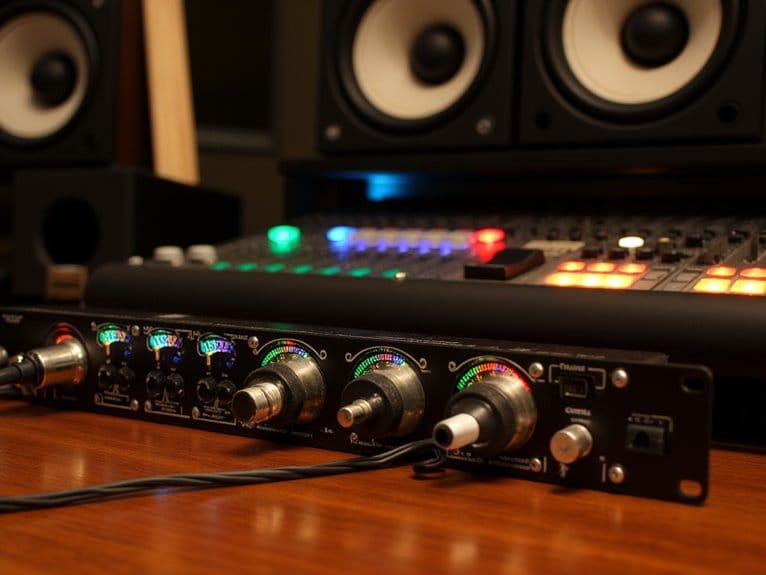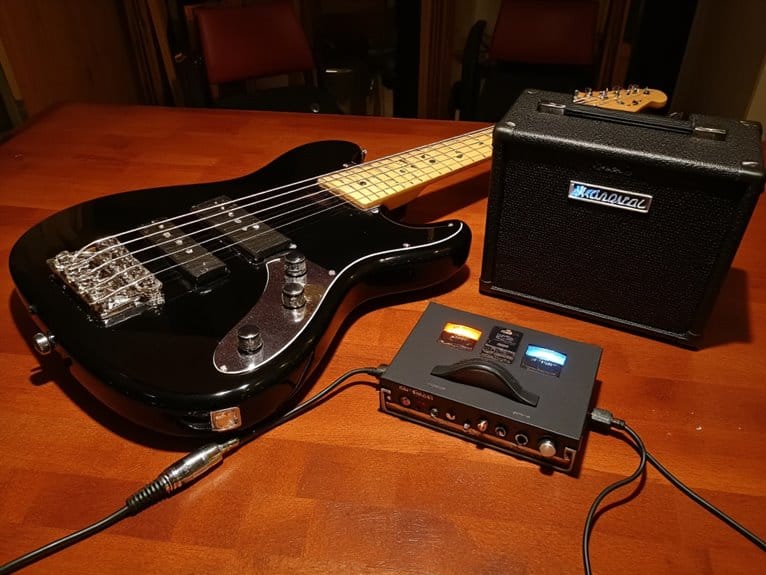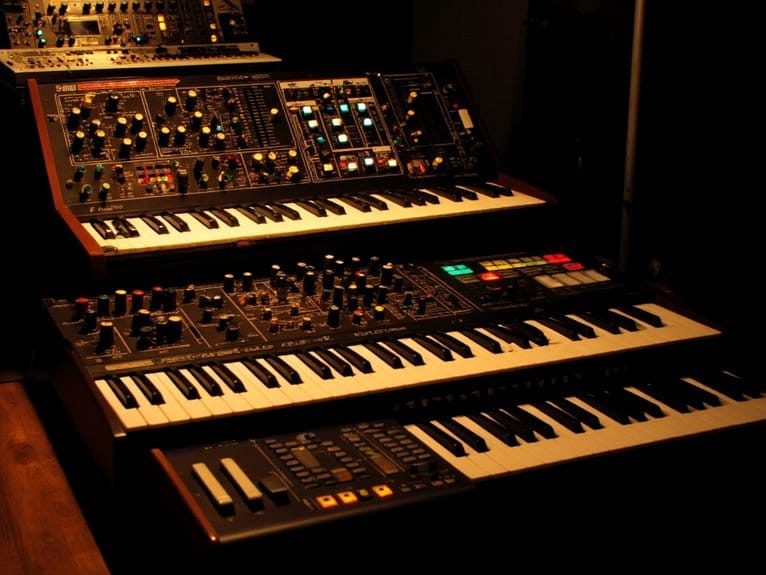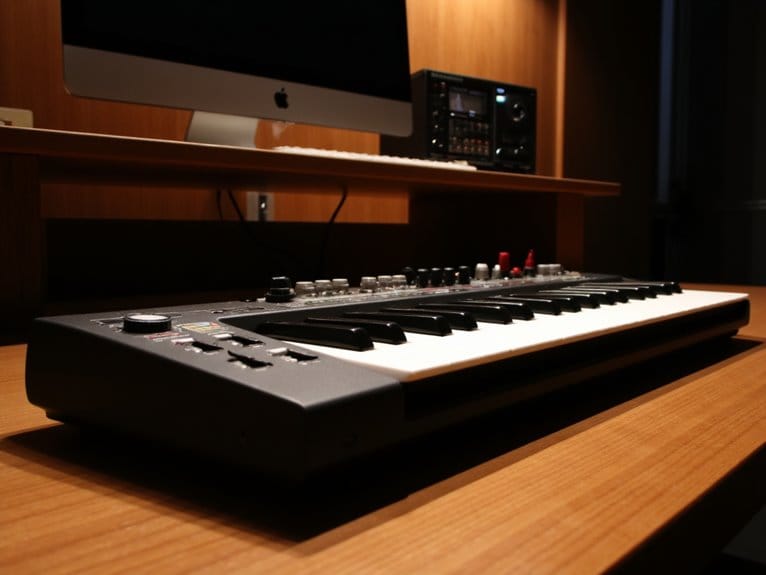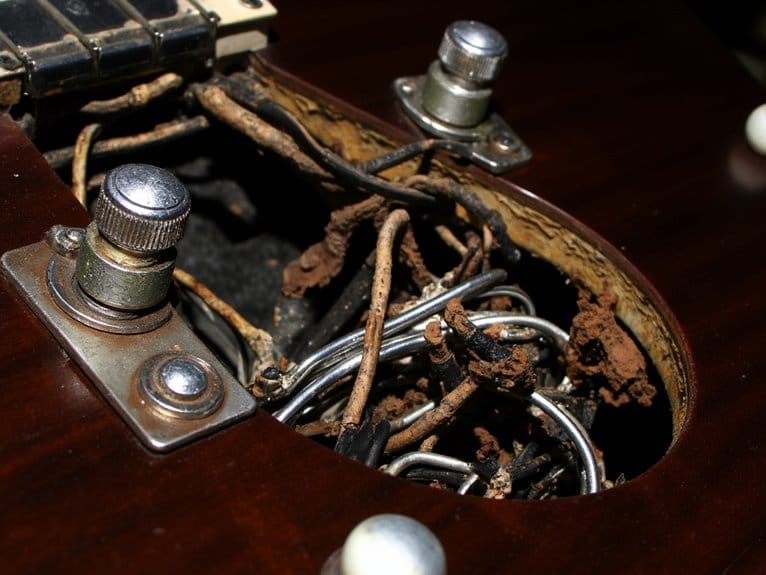We’re Probably Using Our Soft Amp Sims Wrong (Gain Staging)
You’re likely overdriving your amp sim’s input, causing harsh digital clipping instead of warm musical saturation. Most guitarists target levels that are too hot, creating square-wave artifacts and compressing dynamic range into a lifeless, amateur sound. Proper gain staging requires hitting your interface at -18 dBFS, maintaining headroom through your effects chain, and allowing your amp sim to breathe with consistent levels that preserve subtle tonal details and sit properly in your mix-and there’s a systematic approach that’ll transform your recordings.
We are supported by our audience. When you purchase through links on our site, we may earn an affiliate commission, at no extra cost for you. Learn more.
Notable Insights
- Digital clipping from overdriven signals creates harsh harmonics and square-wave artifacts that destroy musicality and sound amateurish.
- Proper gain staging maintains dynamic range, preventing the squashed, lifeless sound that makes tracks difficult to mix professionally.
- Target -18 dBFS through your amp sim input to achieve optimal non-linear saturation while preserving essential headroom.
- Poor audio interfaces with suboptimal preamps and converters introduce noise and clarity issues that compromise your entire signal chain.
- Follow the staged approach: -18 dBFS pre-amp, -18 dBFS amp sim, -12 dBFS post-amp, and -6 dBFS final output levels.
The Hidden Cost of Running Your Signal Too Hot
When you’re pushing your guitar signal into a soft amp sim like it’s a real tube amp that can handle the abuse, you’re actually setting yourself up for a world of sonic disappointment that’ll haunt your mix later. Instead, it’s crucial to treat guitar amp plugins with the same respect you would give a physical amp. Overloading the input can lead to harsh frequencies and unwanted clipping that are difficult to rectify in the mixing process. By approaching your signal chain thoughtfully, you can preserve the clarity and richness of your tone, allowing your mixes to shine.
Those clipping consequences aren’t just technical mumbo-jumbo-they’re actively destroying your tone’s musicality by introducing harsh high-frequency harmonics that’ll make listeners reach for the volume knob.
Digital clipping destroys your tone’s musicality by adding harsh frequencies that instantly repel listeners and kill your mix’s appeal.
The distortion types you get from overdriving digital systems bear little resemblance to the warm saturation you’re chasing, instead creating square-wave artifacts that sound cheap and amateur. Digital clipping occurs when your signal exceeds the representational range in your DAW’s processing chain, fundamentally altering the character of your sound.
I’ve learned this lesson the hard way: clipped signals reduce your dynamic range, making everything sound squashed and lifeless, while damaging your ability to sit properly in a full mix. High-quality interfaces with superior dynamic range specifications can capture subtle details without distortion, preserving the natural character of your guitar tone. Once you’ve clipped your audio during recording, restoration becomes extremely challenging and may never fully recover the original quality. Modern interfaces featuring zero-latency monitoring allow you to hear your guitar tone in real-time without the timing delays that can throw off your performance.
Why Your Audio Interface Is Sabotaging Your Guitar Tone
But even if you’ve mastered proper gain staging and avoided clipping your amp sims, there’s another culprit lurking in your signal chain that’s quietly undermining your guitar tone before it ever reaches those carefully crafted digital amplifiers.
Your audio interface might be sabotaging your sound through poor preamp performance, inadequate input impedance matching, and suboptimal driver optimization that degrades signal integrity from the start.
Here’s what’s likely compromising your audio quality:
- Cheap preamps and converters introduce noise while reducing tone clarity through inferior analog-to-digital conversion.
- Input impedance mismatches with active pickups create weak, muffled signals that lack presence.
- Latency issues and poor driver optimization disrupt timing perception, affecting how you interact with amp sims.
Cable quality matters too-cheap cables further degrade signal integrity before processing begins. Adding a preamp plugin before your amp sim can dramatically enhance clarity and presence, transforming weak DI signals into professional-quality tracks without requiring expensive hardware upgrades. Remember that the surrounding production elements in your mix often determine whether your guitar tone sounds professional, regardless of your interface quality.
A Step-by-Step Approach to Proper Amp Sim Gain Staging
Once you’ve identified and addressed your audio interface issues, the real work begins with methodical gain staging that’ll transform your amp sim from a disappointing digital approximation into a convincing guitar tone. I’ll walk you through a systematic approach that preserves dynamic range while optimizing tone quality through proper signal levels and gain structure. One key technique to enhance your sound further is understanding what is reamping in music, which allows you to process your recorded guitar tracks through different amplifiers and effects after the initial recording. This flexibility can lead to significantly richer tones and more creative possibilities in your productions. By carefully adjusting the reamp levels and experimenting with various settings, you can find the ideal sonic signature that suits your music perfectly.
Remember that the amp’s tonal characteristics are fundamentally influenced by your DI track’s recording level, making consistency in signal strength absolutely critical for professional results. Virtual amps respond with non-linear saturation when pushed beyond their optimal input ranges, mimicking the behavior of their physical counterparts under stress.
| Stage | Target Level | Input Gain Setting | Output Gain Adjustment | Purpose |
|---|---|---|---|---|
| Pre-Amp | -18 dBFS | 12:00 position | Unity gain | Signal preparation |
| Amp Sim | -18 dBFS | Match input level | Maintain headroom | Core tone shaping |
| Effects Chain | -18 dBFS | Effect-dependent | Volume control neutral | Processing optimization |
| Post-Amp | -12 dBFS | N/A | 3-6 dB headroom | Mix preparation |
| Final Output | -6 dBFS | Track fader | Session consistency | Plugin processing ready |
On a final note
You’ve probably been overdriving your audio interface’s preamps this whole time, like I did for years before figuring this out. Keep your input levels around -18dBFS, set your interface gain conservatively, and let the amp sim handle the heavy lifting. Your tone will thank you with cleaner transients, better dynamics, and that elusive “amp-like” response you’ve been chasing. Proper gain staging isn’t glamorous, but it’s everything.

